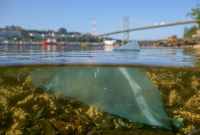An article published in the National Observer on April 5, entitled “Cutting back on waste is possible — if you can afford it,” states that reducing waste is a privilege. I disagree. There is a lot that can be done without sacrifice. And, in my experience, reducing waste actually saves money. Below, I’ll explain steps individuals can take, regardless of income.
The perception that living a low-waste lifestyle is expensive is perpetuated by the images we see on social media of beautiful lives in minimalist homes.
Canadian Anne-Marie Bonneau, author of the just-published book The Zero Waste Chef, says: “For most people, real-life zero waste does not look like Instagram zero waste. Online images create a misconception that in order to reduce our waste, we need to buy all kinds of expensive gear and do zero waste perfectly, never producing a piece of trash.”
In fact, there is no such thing as a “zero-waste” lifestyle. Even if we manage to buy everything in bulk with our own containers, our purchases were shipped from somewhere else, likely in plastic.
But it is nonetheless important to try to reduce our individual contribution to the waste problem because it all adds up. And the exciting part is that simple actions taken by many people can result in significant reductions in waste and carbon emissions.
So what does real-life zero-waste living look like, and why should we try our best to achieve it?
First, let’s discuss plastics. The article notes that Canadians are responsible for more than three million tonnes of plastic waste each year, only nine per cent of which is recycled. That is a problem.
And plastic waste is not one problem. It is many problems. Besides marine pollution (we’ve all seen images of plastic islands floating in the ocean), the plastics industry is a large and growing contributor to climate change. And plastics production facilities emit pollutants that are toxic to anyone who lives nearby.
Government, of course, needs to do its part. Canada has a goal to achieve zero plastic waste by 2030, and proposed legislation would ban many single-use plastics, including plastic bags, straws, cutlery and foodware. This legislation is expected to be finalized by the end of 2021.
But, meanwhile, as consumers, we also have an important opportunity to seek out non-plastic packaging alternatives every time we shop.
The article correctly notes that zero-waste and health food stores are often more expensive than larger supermarkets. However, it’s entirely possible to avoid significant amounts of plastic packaging without having to shop in special stores.
The produce aisles of large Canadian supermarket chains like Loblaws, Safeway and Metro sell many unpackaged produce items. Consumers can bring their own reusable produce bags and shop for “naked” (unpackaged) produce. Most of these stores have a large array of loose and unpackaged fruits and vegetables.

And if you forget to bring your own reusable produce bags, you can go without. I often bring a kitchen towel and set it inside the cart where I place my onions, garlic, bananas and other produce that has its own nature-provided packaging. After paying, I add this unpackaged produce to my shopping bags.
Imagine all the single-use plastic bags Canadians would avoid by simply buying their produce unpackaged. An easy thing to do that doesn’t cost money and doesn’t involve multiple trips to specialty stores.
Second, let’s discuss food waste. Food waste is a large environmental issue, as food that ends up in landfills produces methane, a powerful greenhouse gas. And the surprising thing is that the largest portion of food waste in rich countries like Canada and the U.S. comes from households, not from restaurants, cafeterias, hotels or farms. This means individuals can positively affect the climate crisis by ensuring they eat what they buy.
To avoid food waste, you don’t need money. You simply need to have a plan for what you bring home. Refrigerated foods in particular need to be tracked so that they don’t expire before they are consumed.
One trick we use in my family is to do a two-minute daily fridge check. The purpose is to bring forward any food near the end of its shelf life. We label one shelf in our fridge “Eat Me First” to avoid confusion. By incorporating this simple habit into our daily life, we’ve substantially decreased our trash volume.
A zero-waste lifestyle can actually save you money. The average Canadian household wastes $1,100 worth of food a year, according to the National Zero Waste Council. Consuming your leftovers is one of the smartest things a budget-conscious person can do.
Ultimately each of us — busy, financially stable or financially stretched — has a role to play in addressing the climate and waste crises.
Stephanie J. Miller is the author of Zero Waste Living, the 80/20 Way: The Busy Person’s Guide to a Lighter Footprint and the founder of Zero Waste in D.C. Previously, she led the climate change agenda at the International Finance Corporation, the private-sector arm of the World Bank.






Comments
Another idea: save trees and packaging by getting a bidet attachment for the toilet. For $75, you'll never have to buy toilet paper again. They are easily installed, so a renter can put one in and then take it with them.
Every single thing you do or use these days relies on plastic. As long as our system is built on plastic, even 50% of consumers being conscientious is not going to help. Tragedy of the commons. Get your garden ready for survival.